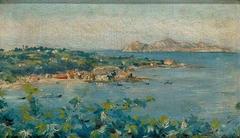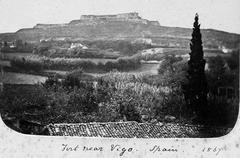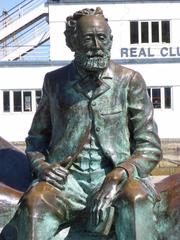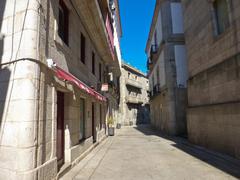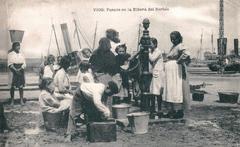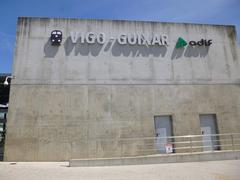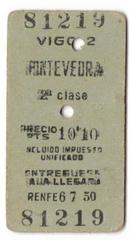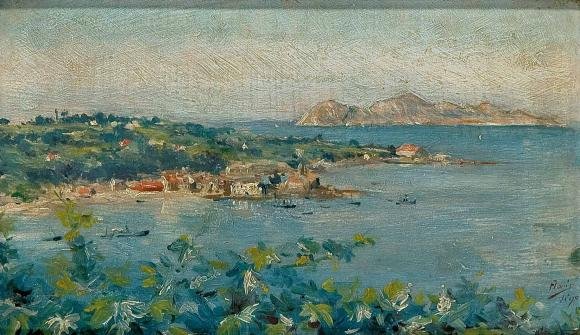
Cíes Islands Visiting Guide: Vigo, Spain – Tickets, Hours, Attractions, and Essential Tips
Date: 14/06/2025
Introduction
The Cíes Islands, nestled off the northwest coast of Galicia, Spain, are a captivating archipelago celebrated for pristine beaches, exceptional biodiversity, and profound historical significance. As part of the Atlantic Islands of Galicia National Park, the islands offer a harmonious blend of natural beauty, archaeological heritage, and ecological importance. Travelers can expect striking Atlantic landscapes, world-renowned beaches like Playa de Rodas, and diverse ecosystems supporting rare flora and fauna, including one of Europe’s largest colonies of yellow-legged gulls (lasislascies.com; UNESCO; en.wikipedia.org).
To protect this natural treasure, stringent regulations are in place: visitor numbers are capped, tickets and permits must be obtained in advance, and overnight stays are limited to a regulated campsite. Reaching the islands is possible only by ferry, with regular departures from Vigo, Cangas, and Baiona (portosecreto.co; Direct Ferries). This comprehensive guide details the islands’ history, ecological highlights, visiting hours, ticketing procedures, accessibility, top attractions, and practical advice for a seamless and enriching visit.
Contents
- Historical Overview
- Visitor Information: Hours, Tickets, and Permits
- Getting to the Cíes Islands: Ferries and Access
- Accessibility and On-Island Facilities
- Where to Stay and Eat
- Top Attractions and Activities
- Sustainable Tourism and Conservation Rules
- Travel Tips and Best Times to Visit
- Nearby Vigo and Other Galicia Highlights
- Frequently Asked Questions (FAQ)
- Summary and Recommendations
- Sources
Historical Overview
Prehistoric and Ancient Periods
The Cíes Islands have been inhabited or visited since at least 3,500 BCE, with Bronze and Iron Age settlements (“castros”) attesting to early human presence. Archaeological finds such as stone tools and pottery are displayed at the Pontevedra Museum, illustrating the islands’ significance to Celtic and seafaring communities (lasislascies.com).
Roman and Medieval Eras
Known to the Romans as the “Islands of the Gods,” the Cíes served as important maritime waypoints. Discoveries of Roman artifacts—amphorae, ceramics, and jewelry—point to a history of trade and navigation (ciespatrimonio.vigo.org). Medieval records show the islands as sanctuaries for monks, hermits, and fishermen, and as strategic outposts during regional conflicts.
Modern Era and Conservation
By the 20th century, harsh conditions led to depopulation, allowing nature to reclaim the islands. In 1980, they were declared a Nature Reserve, and since 2002, they have formed the heart of the Atlantic Islands of Galicia National Park, with strict protections to preserve their biodiversity (en.wikipedia.org; lasislascies.com; portosecreto.co).
Maritime Heritage
Beneath the surrounding waters, numerous shipwrecks and ancient anchors reveal a rich seafaring legacy (ciespatrimonio.vigo.org). The islands are also a haven for marine research, with unique maërl beds and habitats critical for Atlantic species (UNESCO).
Visitor Information: Hours, Tickets, and Permits
Visiting Hours
- Season: Open mainly from April to October, with peak season (Easter to September 15) offering daily access.
- Daily Schedule: Generally from 8:00 AM until sunset. Timetables are set by ferry schedules and daylight hours (Lonely Planet; Ancient Origins).
- Off-Season: From October to March, the islands are closed for conservation, except for limited, guided visits (Novo Monde).
Tickets and Visitor Permits
- Daily Visitor Quota: Strictly limited to 1,800 per day during high season, and 450 in low season (Lonely Planet; Novo Monde).
- Permit Process: Apply for a permit via the Xunta de Galicia website before purchasing ferry tickets. Some ferry companies handle the permit automatically (Novo Monde).
- Ferry Tickets: Must be booked in advance; select both departure and return times (Direct Ferries; Guias Viajar).
- Campsite Stays: Require both a permit and advance reservation (Official Xunta de Galicia Site).
Failure to secure a permit and ticket in advance may result in denied boarding.
Getting to the Cíes Islands: Ferries and Access
Ferry Connections
- Main Departure Points: Vigo (most frequent), Cangas, and Baiona (Turismo de Vigo; Direct Ferries).
- Duration: About 40–45 minutes each way.
- Ferry Operators: Mar de Ons, Naviera Nabia, and others (Packing Up the Pieces).
- San Martiño Island: Only accessible by private boat with a special anchoring permit (Turismo de Vigo).
Ticket Prices (2025)
- Adults: €21.50–€48 round trip (varies by season and operator).
- Children (5–12 years): €10–€20.
- Under 5: Free (Guias Viajar).
Reserve early, especially for weekends and holidays.
Accessibility and On-Island Facilities
- Pedestrian Only: No vehicles or bicycles allowed (Turismo de Vigo).
- Accessible Areas: Main port, Rodas Beach, and visitor center are relatively accessible; most trails are rugged and may not suit those with limited mobility.
- Restrooms: Available near main beaches and the campsite.
- Visitor Center: Housed in the historic San Estevo monastery, offering exhibits and information.
Where to Stay and Eat
Accommodation
- Camping: The official campsite (open mid-May to mid-September and Easter) is the only overnight option (Lonely Planet; Novo Monde).
- Capacity: ~800 people
- Facilities: Tent rentals, showers, toilets, shop, cafeteria
- Wild Camping: Prohibited
Food and Supplies
- Restaurants: Three operate on Monteagudo Island during peak season (Idealista).
- Picnics: Bringing your own food and water is advised.
- Waste Policy: All waste must be packed out; there are no public garbage bins (Lonely Planet).
Top Attractions and Activities
Rodas Beach
- Highlights: Often cited as one of the world’s best beaches for its fine white sand, turquoise waters, and natural lagoon (Traveldrafts).
- Tip: Arrive early, especially in summer.
Hiking and Viewpoints
- Faro de Cíes Trail: 7 km round trip to Monte Faro lighthouse for panoramic views (Ancient Origins).
- Alto do Príncipe Trail: 3 km to a stunning rocky vantage point.
- Monteagudo and O Faro da Porta Trails: Quieter routes for nature and solitude.
Birdwatching and Wildlife
- Seabird Sanctuary: Home to 22,000+ breeding pairs of yellow-legged gulls, cormorants, shags, and migratory birds (Ancient Origins; UNESCO).
- Marine Life: Snorkeling and swimming reveal clear waters and diverse fish (Travel Planner Holic).
Historical Sites
- Ancient Ruins: Remains of Iron Age settlements and medieval monasteries.
- Shipwrecks and Pirate Legends: Underwater heritage accessible to researchers (Ancient Origins).
Other Beaches
- Figueiras Beach: Known for tranquility, snorkeling, and as a nudist beach.
- Nosa Señora and Bolera Beaches: Offer seclusion and family-friendly settings.
Sustainable Tourism and Conservation Rules
- Permits Required: For all visitors and campers (Official Xunta de Galicia Site).
- No Pets: To protect wildlife (Novo Monde).
- No Fires or Wild Camping: Strictly enforced.
- No Removal of Natural Items: Leave shells, plants, and rocks in place.
- Stay on Trails: To avoid disturbing sensitive habitats.
- Carry Out All Waste: “Leave no trace” policy is mandatory.
Travel Tips and Best Times to Visit
- Best Season: Late May to early September for optimal weather and open facilities (Lonely Planet).
- Weather: Atlantic climate—be prepared for sudden changes, sun, wind, and cool water.
- What to Bring: Sun protection, layers, sturdy shoes, water, and cash (no ATMs).
- Book Early: Both ferry tickets and campsite spots fill quickly during peak periods.
Nearby Vigo and Other Galicia Highlights
- Vigo Old Town: Explore Castro Fortress, Casco Vello, and Samil Beach for culture and history.
- Galicia: Extend your trip to Santiago de Compostela or other regional treasures for a broader experience.
Frequently Asked Questions (FAQ)
Q: What are the Cíes Islands’ visiting hours?
A: Generally from 8:00 AM to sunset, April through September. Closed October to March except for special visits.
Q: How do I get permits and tickets?
A: Apply for a permit via the Xunta de Galicia website and book ferry tickets with your chosen operator.
Q: Can I camp on the islands?
A: Only at the official campsite near Rodas Beach, with prior reservation.
Q: Are pets allowed?
A: No, to protect wildlife.
Q: Are the islands accessible for people with disabilities?
A: Some paths and facilities are accessible, but most trails are rugged.
Q: What should I bring?
A: Food, water, sun protection, sturdy shoes, and all personal waste back to the mainland.
Summary and Recommendations
The Cíes Islands are a remarkable testament to Galicia’s natural and cultural heritage, offering pristine beaches, diverse wildlife, and a rich historic landscape. Thorough planning is essential—secure permits and ferry tickets well in advance, respect conservation rules, and prepare for minimal facilities. Enhance your experience by exploring nearby Vigo and other Galician destinations (ciespatrimonio.vigo.org; lasislascies.com; Lonely Planet; Novo Monde; Xunta de Galicia; Direct Ferries).
For real-time updates, interactive maps, and exclusive tips, download the Audiala app and follow our social media channels.
Sources
- Brief History of the Cíes Islands, Las Islas Cíes
- Cíes Islands History and Heritage, Cíes Patrimonio Vigo
- The Cíes Islands, Las Islas Cíes
- Cíes Islands, Wikipedia
- Cíes Islands Paradise in Galicia, Porto Secreto
- Discover the Cíes Islands: Visiting Hours, Tickets, and Ecological Highlights, UNESCO Tentative List
- Cíes Islands Ferry Information, Direct Ferries
- How to Visit Cíes Islands, Packing Up the Pieces
- Cíes Islands Visitor Information, Xunta de Galicia
- Cíes Islands Travel Guide, Lonely Planet
- Things to Do in Vigo and Cíes Islands, The Tourist Checklist
- Cíes Islands Visitor Tips, Novo Monde
